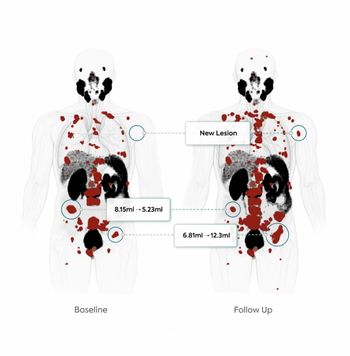
Types of PSMA-PET Scans in Prostate Cancer
Experts highlight gallium-based and PyL PSMA-PET scans for use in prostate cancer, commenting on approvals as well as how the agents are made.
Episodes in this series

Umesh Oza, MD: So, we both mentioned PSMA-PET [prostate-specific membrane antigen-positron emission tomography]. You and I both know there are 2 radioisotopes bound to different agents, PSMA [and] amino acid, among other things. Can you touch on what 2 different radionuclides are available for PSMA-PET, just generally? Then we can talk a little bit more specifically about advantages and disadvantages.
Jaideep S. Sohi, MD: Absolutely. The first tracer that comes to mind is gallium-68 PSMA. That’s the one that has been utilized in Australia and Europe for the past about 7-plus years. Our first FDA-approved tracer in the US was gallium-68 PSMA, which was developed by [University of California San Francisco] and [University of California, Los Angeles] back in December 2020. As the name suggests, it’s a gallium-based imaging agent. The second PSMA agent that’s available is F-18, or fluorine-18 PSMA, which was approved, I believe, in May 2021. That’s a newer agent, and now both are in utilization and practice.
Umesh Oza, MD: That’s interesting because on our side, where we are, in a big city, Dallas, we saw the F-18 agent show up first, and then we saw the gallium-68. You’re telling me that, in Europe and the rest of Australia, it’s been around for almost 7 years. It’s interesting how things work out about availability in big cities like this. But I’m hoping we’re seeing more of a balance and that we’re looking at both tracers. We have enough data to look at what’s best for our patients, what subset of patients, what scenarios, and things like that. Let’s just talk first about how each one is made. How are they produced? Is there a difference between the gallium and the fluorinated PSMA agent?
Jaideep S. Sohi, MD: Yes, and again, just to complete the loop from the prior topic, I think you’ve mentioned that you’ve seen higher utilization, or greater utilization, or earlier adoption of F-18 compared with gallium. I think part of the reason is that the first tracer, although it was gallium-68 that was approved in the US, that was, technically available to anybody, but really in practical terms, was available to patients who could travel to those institutions.
Then, of course, everything was approved, and then that became available. Maybe that’s the reason why we had the approval of a tracer, but it was not highly, widely available. I think with regard to how they’re produced, the gallium-68 is a generator-produced isotope, and F-18 is produced by cyclotron. Do you want to go into a little detail? How about you? Go into some detail about what the difference between a generator and a cyclotron is.
Umesh Oza, MD: Sure, [with] a cyclotron, you’ve got to have some space. It’s very highly radioactive, [with a radioactive area of] what used to be a football field. But now they’re smaller than that. But they’re very high-radiation areas. They need very big regions of shielding, concrete, and lead, and are very expensive. And that’s where our fluorinated agents are coming from. For our mainstay F-18 PET-CT, we do it for every other malignancy. A generator is something that you have, a parent, if you will. Then it decays to a, we call it a daughter in the nuclear medicine world. A generator will make that as it decays, [and] you can pull off what you’re trying to produce. In this case, it’s [such a] smaller piece of equipment. It does have its own half-life and decays. But once you have that generator, you can produce that isotope locally, fairly easily, efficiently. And you can distribute those generators to smaller areas. You can’t move a cyclotron and say, “Hey, I want this cyclotron in my small town right now,” but you can move generators, or you can have a setup where the generators are closer to these smaller towns.
Transcript is AI-generated and edited for clarity and readability.
Newsletter
Stay at the forefront of radiology with the Diagnostic Imaging newsletter, delivering the latest news, clinical insights, and imaging advancements for today’s radiologists.






























